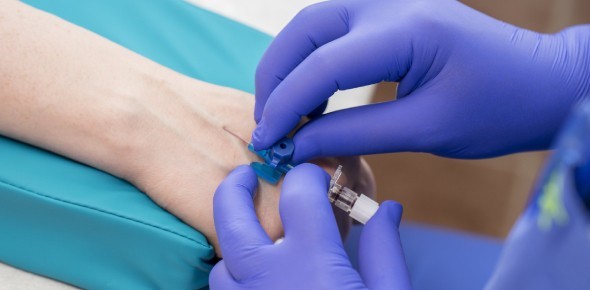A nurse is preparing to discharge a client who is postoperative following a total hip arthroplasty. Which of the following equipment should the nurse ensure that the client has available at home prior to discharge?
Continuous passive motion device.
Elevated toilet seat.
Trapeze bar.
Compression garment.
The Correct Answer is B
Choice A rationale:
Providing a continuous passive motion (CPM) device is not necessary for a client following a total hip arthroplasty. CPM devices are more commonly used after knee arthroplasty to improve joint mobility.
Choice B rationale:
Ensuring the client has an elevated toilet seat at home is important following a total hip arthroplasty. The elevated seat reduces the amount of hip flexion required during toileting, which helps prevent hip dislocation and strain on the surgical site.
Choice C rationale:
Providing a trapeze bar is not essential for a client following a total hip arthroplasty. Trapeze bars are typically used to assist with repositioning in bed for clients with limited mobility, but they are not specific to hip arthroplasty recovery.
Choice D rationale:
Providing a compression garment is not necessary after total hip arthroplasty. Compression garments are often used for conditions like venous insufficiency or to manage swelling, but they are not routinely used for hip arthroplasty recovery.
Nursing Test Bank
Naxlex Comprehensive Predictor Exams
Related Questions
Correct Answer is C
Explanation
Choice A rationale:
Increasing the intake of high-fiber foods is not relevant to addressing the client's dry mouth caused by benztropine. High-fiber foods are commonly recommended for managing constipation, a symptom often associated with Parkinson's disease, but it does not address the issue of dry mouth.
Choice B rationale:
Chewing sugarless gum can stimulate saliva production and help alleviate dry mouth. However, it is not the most appropriate recommendation for a client taking benztropine, as gum-chewing may interfere with the effectiveness of the medication or exacerbate other symptoms.
Choice C rationale:
Moistening the mouth with lemon-glycerin swabs is the most suitable recommendation for a client experiencing dry mouth due to benztropine. Lemon-glycerin swabs can help increase saliva production and provide relief from the discomfort of dry mouth without interfering with the medication's efficacy.
Choice D rationale:
Rinsing the mouth with nystatin is used to treat fungal infections in the mouth (oral thrush) and is not relevant to address the side effect of dry mouth caused by benztropine.
Correct Answer is C
Explanation
Verify that the client has adequate IV access.

Choice A rationale:
Administering vasopressin to the client might be necessary to manage the hemorrhage, but before any medication administration, it is crucial to ensure the client has adequate IV access. Vasopressin is a vasoconstrictor and can help control bleeding from esophageal varices, but its effectiveness relies on IV access to deliver the medication promptly.
Choice B rationale:
Requesting blood from the blood bank is essential for a client experiencing significant bleeding. However, the priority action is to verify IV access to administer any necessary blood products.
Choice C rationale:
This is the correct choice. Before initiating any interventions, ensuring the client has appropriate IV access is a priority. Adequate IV access is necessary to administer fluids, medications, or blood products promptly and effectively stabilize the client's blood pressure.
Choice D rationale:
Inserting an indwelling urinary catheter is not the priority action in this situation. While monitoring urine output is important, it should be secondary to addressing the client's hypotension and hemorrhage.
Whether you are a student looking to ace your exams or a practicing nurse seeking to enhance your expertise , our nursing education contents will empower you with the confidence and competence to make a difference in the lives of patients and become a respected leader in the healthcare field.
Visit Naxlex, invest in your future and unlock endless possibilities with our unparalleled nursing education contents today
Report Wrong Answer on the Current Question
Do you disagree with the answer? If yes, what is your expected answer? Explain.
Kindly be descriptive with the issue you are facing.
